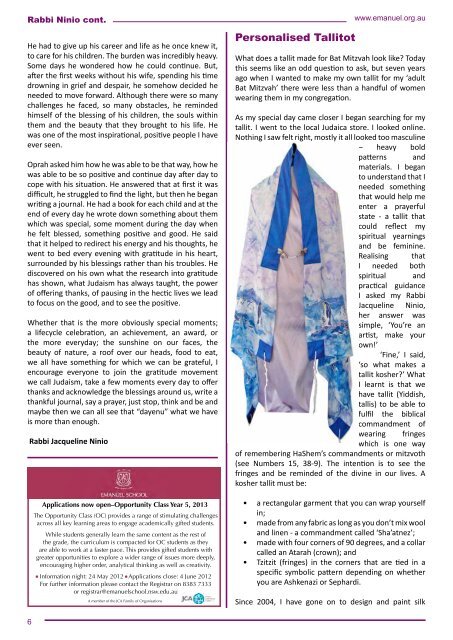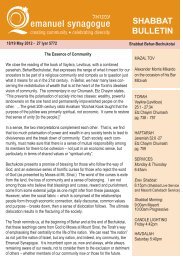TELL May - July 2012 - Emanuel Synagogue
TELL May - July 2012 - Emanuel Synagogue
TELL May - July 2012 - Emanuel Synagogue
Create successful ePaper yourself
Turn your PDF publications into a flip-book with our unique Google optimized e-Paper software.
Rabbi Ninio cont.<br />
He had to give up his career and life as he once knew it,<br />
to care for his children. The burden was incredibly heavy.<br />
Some days he wondered how he could continue. But,<br />
after the first weeks without his wife, spending his time<br />
drowning in grief and despair, he somehow decided he<br />
needed to move forward. Although there were so many<br />
challenges he faced, so many obstacles, he reminded<br />
himself of the blessing of his children, the souls within<br />
them and the beauty that they brought to his life. He<br />
was one of the most inspirational, positive people I have<br />
ever seen.<br />
Oprah asked him how he was able to be that way, how he<br />
was able to be so positive and continue day after day to<br />
cope with his situation. He answered that at first it was<br />
difficult, he struggled to find the light, but then he began<br />
writing a journal. He had a book for each child and at the<br />
end of every day he wrote down something about them<br />
which was special, some moment during the day when<br />
he felt blessed, something positive and good. He said<br />
that it helped to redirect his energy and his thoughts, he<br />
went to bed every evening with gratitude in his heart,<br />
surrounded by his blessings rather than his troubles. He<br />
discovered on his own what the research into gratitude<br />
has shown, what Judaism has always taught, the power<br />
of offering thanks, of pausing in the hectic lives we lead<br />
to focus on the good, and to see the positive.<br />
Whether that is the more obviously special moments;<br />
a lifecycle celebration, an achievement, an award, or<br />
the more everyday; the sunshine on our faces, the<br />
beauty of nature, a roof over our heads, food to eat,<br />
we all have something for which we can be grateful, I<br />
encourage everyone to join the gratitude movement<br />
we call Judaism, take a few moments every day to offer<br />
thanks and acknowledge the blessings around us, write a<br />
thankful journal, say a prayer, just stop, think and be and<br />
maybe then we can all see that “dayenu” what we have<br />
is more than enough.<br />
Rabbi Jacqueline Ninio<br />
6<br />
Applications now open–Opportunity Class Year 5, 2013<br />
The Opportunity Class (OC) provides a range of stimulating challenges<br />
across all key learning areas to engage academically gifted students.<br />
While students generally learn the same content as the rest of<br />
the grade, the curriculum is compacted for OC students as they<br />
are able to work at a faster pace. This provides gifted students with<br />
greater opportunities to explore a wider range of issues more deeply,<br />
encouraging higher order, analytical thinking as well as creativity.<br />
Information night: 24 <strong>May</strong> <strong>2012</strong> Applications close: 4 June <strong>2012</strong><br />
For further information please contact the Registrar on 8383 7333<br />
or registrar@emanuelschool.nsw.edu.au<br />
A member of the JCA Family of Organisations<br />
Personalised Tallitot<br />
www.emanuel.org.au<br />
What does a tallit made for Bat Mitzvah look like? Today<br />
this seems like an odd question to ask, but seven years<br />
ago when I wanted to make my own tallit for my ‘adult<br />
Bat Mitzvah’ there were less than a handful of women<br />
wearing them in my congregation.<br />
As my special day came closer I began searching for my<br />
tallit. I went to the local Judaica store. I looked online.<br />
Nothing I saw felt right, mostly it all looked too masculine<br />
– heavy bold<br />
patterns and<br />
materials. I began<br />
to understand that I<br />
needed something<br />
that would help me<br />
enter a prayerful<br />
state - a tallit that<br />
could reflect my<br />
spiritual yearnings<br />
and be feminine.<br />
Realising that<br />
I needed both<br />
spiritual and<br />
practical guidance<br />
I asked my Rabbi<br />
Jacqueline Ninio,<br />
her answer was<br />
simple, ‘You’re an<br />
artist, make your<br />
own!’<br />
‘Fine,’ I said,<br />
‘so what makes a<br />
tallit kosher?’ What<br />
I learnt is that we<br />
have tallit (Yiddish,<br />
tallis) to be able to<br />
fulfil the biblical<br />
commandment of<br />
wearing fringes<br />
which is one way<br />
of remembering HaShem’s commandments or mitzvoth<br />
(see Numbers 15, 38-9). The intention is to see the<br />
fringes and be reminded of the divine in our lives. A<br />
kosher tallit must be:<br />
• a rectangular garment that you can wrap yourself<br />
in;<br />
• made from any fabric as long as you don’t mix wool<br />
and linen - a commandment called ‘Sha’atnez’;<br />
• made with four corners of 90 degrees, and a collar<br />
called an Atarah (crown); and<br />
• Tzitzit (fringes) in the corners that are tied in a<br />
specific symbolic pattern depending on whether<br />
you are Ashkenazi or Sephardi.<br />
Since 2004, I have gone on to design and paint silk







